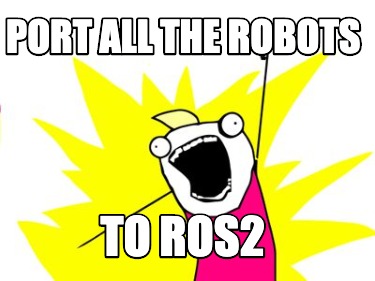Porting EtherbotiX to ROS2
25 Aug 2020maxwell robomagellan robots ros2 
Now that the UBR-1 is running pretty well under ROS2, I have started to also port Maxwell and the Robomagellan robot to ROS2. Both depend on my etherbotix drivers package, so that is the first package to port.
Etherbotix in ROS2
In ROS1, the etherbotix_python package was written in Python and
leveraged some code from the arbotix_ros package (mainly for the
controllers). I decided while porting things to ROS2 that I would migrate to using
C++ and leverage the robot_controllers
which I had recently ported to ROS2.
Since this was effectively a new package, I used the ros2 pkg create command to setup the CMakeLists.txt, package.xml and other boiler plate stuff.
I then started to setup the node based off my very old
asio_ros example.
At some point I should probably setup a test to see how accurate ROS2 timers are,
but I knew for sure that this code would work so I stuck with boost::asio.
Python Wrappers
In ROS1 I had a number of scripts for interacting with the Etherbotix. For some
of these, such as read_etherbotix, it was easy to port them to C++.
For others, such as my motor_trace script which uses matplotlib, I really wanted
to keep the majority of the script in Python. To accomplish this, I wrapped my
underlying C++ drivers using Boost Python.
It required a bit of CMake:
find_package(PythonLibs REQUIRED)
find_package(Boost REQUIRED python)
ament_python_install_package(${PROJECT_NAME})
add_library(etherbotix_py SHARED ...)
set_target_properties(etherbotix_py PROPERTIES
LIBRARY_OUTPUT_DIRECTORY ${CMAKE_CURRENT_BINARY_DIR}/${PROJECT_NAME}
PREFIX "")
target_link_libraries(etherbotix_py
${Boost_LIBRARIES}
${PYTHON_LIBRARIES}
)
ament_target_dependencies(etherbotix_py ...)
install(
TARGETS etherbotix_py
DESTINATION "${PYTHON_INSTALL_DIR}/${PROJECT_NAME}"
)
I then created a file etherbotix/__init__.py:
from etherbotix.etherbotix_py import Etherbotix
This allowed me to import my C++ class Etherbotix in my scripts with:
from etherbotix import Etherbotix
Why Boost Python? Aren’t there newer things out there? Yes, there are newer things
out there, and I spent a while trying out pybind11 but I just couldn’t
get it to work and reverted to what I knew already.
Exporting Libraries
Most of the ROS2 code I’ve ported has thus far been various nodes, rather than a
library that will be used by other packages (the one exception being
robot_controllers_interface). I hadn’t previously paid super close
attention to how things are exported. There are a few declarations that get
placed at the end of your CMakeLists.txt:
# Tell downstream packages where to find our headers
ament_export_include_directories(include)
# Tell downstream packages our libraries to link against
ament_export_libraries(my_library)
# Help downstream packages to find transitive dependencies
ament_export_dependencies(
rclcpp
)
ament_package()
This code snippet is from my ros2_cookbook project on GitHub. You can also find the full commit for enabling downstream packages to build upon the library exported by the Etherbotix library.
Maxwell Bringup
So why did I have to export the Etherbotix libraries? I had to write a custom controller for the torso on Maxwell, and that controller had to access an Etherbotix instance. This involved a bit of custom code to add both a custom JointHandle and custom Controller. The controller also automatically loads the custom JointHandle.
One of the advantages of using robot_controllers is that several controllers
worked out of the box. I had never actually updated the old Python code to work with
Maxwell’s parallel jaw gripper, but with the ParallelGripperController and a
ScaledMimicController for the second finger, everything worked out of the box.
The controllers for Maxwell are now all setup. You can see the configuration here.
Some Fancy-ish C++
Throughout the driver code we have to construct buffers of various bytes to send to the hardware - often involving arrays of bytes of varying length. This is generally really clean in Python, but in C++ usually results in something like this:
uint8_t len = 0;
buffer[len++] = 0xff;
buffer[len++] = 0xff;
buffer[len++] = Etherbotix::ETHERBOTIX_ID;
buffer[len++] = 5; // Length of remaining packet
buffer[len++] = dynamixel::WRITE_DATA;
if (motor_idx == 1)
{
buffer[len++] = Etherbotix::REG_MOTOR1_VEL;
}
else
{
buffer[len++] = Etherbotix::REG_MOTOR2_VEL;
}
buffer[len++] = (desired_velocity_ & 0xff);
buffer[len++] = (desired_velocity_ >> 8);
buffer[len++] = dynamixel::compute_checksum(buffer, 9);
I decided to come with a cleaner approach, since there are quite a few
instances of this throughout the code base. I ended up creating a
get_write_packet function like I had in the Python code, with this
signature:
inline uint8_t get_write_packet(
uint8_t* buffer,
uint8_t device_id,
uint8_t address,
std::vector<uint8_t> params)
And then using an initializer list to create the variable-size buffers of bytes to send:
uint8_t len = dynamixel::get_write_packet(
buffer,
Etherbotix::ETHERBOTIX_ID,
(motor_idx == 1) ? Etherbotix::REG_MOTOR1_VEL : Etherbotix::REG_MOTOR2_VEL,
{static_cast<uint8_t>(desired_velocity_ & 0xff),
static_cast<uint8_t>(desired_velocity_ >> 8)}
);
Yes, this probably is not the fastest code (since it passes the vector of bytes by-value), but I like how it cleans up the code and none of these vectors are all that large. You can see the full commit on GitHub
Diagnostics
The final part of my etherbotix port was to
add diagnostics
back into the node. diagnostic_msgs are an underused feature in ROS.
They offer a common way to send information about the status of things, mostly
hardware. Drivers like urg_node, the
joy node, and even higher level
filters like robot_localization
publish diagnostics.
While diagnostics can be passed through analyzers to output a diagnostics_agg
topic, I often just use the rqt_runtime_monitor which access the raw
diagnostics topic. I found it was missing in ROS2 - but there is a port, which
hasn’t been merged yet. You can
find that port here.
Next Steps
I’ve made some major progress on running navigation2 on the UBR-1 and that will be the
subject of a post next week. After that I’ll be continuing on bringup of the robomagellan
robot, including integrating robot_localization in ROS2.